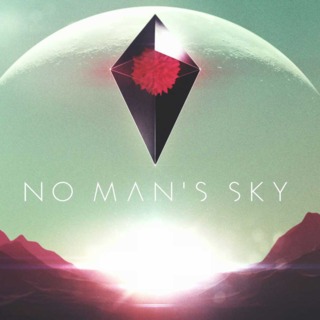The lifeform looks at me in utter despair. It seems trapped in an endless circle of painfully repetitive resource gathering while its inborn curiousness wants it to still venture forth on a journey where quintillions of untapped worlds are just waiting to be discovered. The lifeform notices my own frustrated expression and vibrates in empathy. We'll likely be stuck in this treadmill for quite another while.
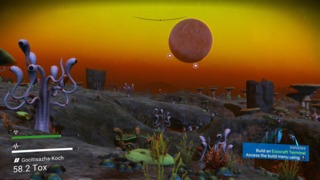
No Man's Sky's worlds are as numerous as they are colorful, and the planets' imaginative landscapes that often appear to be taken right out of a modern art book are one of its biggest appeals. Our first contact with a new solar system is amazing: as we do our first steps on a virgin planet with some exotic sounding name, we feel about as pioneer as Neil Armstrong setting foot on the moon. We hardly see the time pass as we wander around harvesting isotopes, oxides, and silicates, scan bizarre looking species that seem oblivious of Darwin's theory of evolution, interact with same-looking monoliths, scattered remnants of an ancient whole, and “communicate” with the one or other alien weirdo inside a not-yet-abandoned structure. Encounters with animal species, alien lifeforms (the ultimate politically correct term), and sentry drones remain peaceful most of the time, at least on normal difficulty, unless we happen to land on a particularly unwelcoming planet where our mere presence does but provoke a violent sentinel response.

Mostly, though, it is the harsh climate conditions—extreme heat or cold, toxic rain, radiation—or the scarcity of local resources that won't want us to stay any longer, and provided we have enough Plutonium to fuel our Launch Thruster, we just set off to another promising looking destination within our solar system's planetscape, or travel to another nearby cluster on our star map.
In an exascale generated universe such as No Man's Sky, familiarization is not an option as the variety offered largely surpasses our demand, and we'll likely never reach the end of our galaxy albeit theoretically, its center—the game's main though rather adverse objective. The true goal of our journey, however, is exploration for which we need resources for which we need exploration and resources, and it is here exactly that pleasure does eventually become boredom and we start feeling like losing our time...
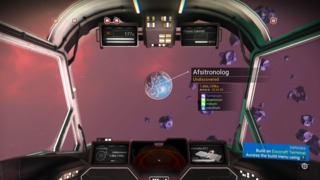
However undiscovered the planets, however unlimited the resources, however unprecedented the alien encounters with the beaked Gek, cunning traders, the beefy Vy'keen, orc-like warriors, and the bemasked Korvax, contriving scientists—many players will already have abandoned the game due to a lack of action before the first actual story elements are even taking place.
“I ache for a past I cannot remember. Every inch of my soul wants to make the leap back. I look to the skies, and the infinity beyond": No Man's Sky's elevated writing is seemingly inspired by the most renowned science fiction classics, but as each bit requires further exploration, and hence resources, its narration unfolds ever so slowly as materialize the different questlines.—Patience Traveller! At the heart of infinity, the secret awaits you.—With the endless farming of supplies as our main occupation, though, story objectives become almost secondary, so that at the begin we hardly notice there being any.
Without proper lead-in, No Man's Sky sets us right onto the track for spendthrift survival: we aka the "Traveller" wake up near our crashed spacecraft; we thankfully accept the guidance offered by a mysterious entity called "The Atlas" to get our ship repaired and craft, then fuel a Hyperdrive in order to be able to leave the current solar system. Alas, from the moment we finally manage to get the blueprint, ineluctably, all our efforts are concentrated on crafting a handsome supply of warp cells (a stack of which we might easily lose when dying during a space battle) indispensable for navigating on our star map.
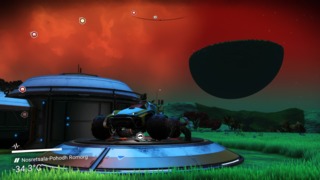
After traveling to another solar system, we are to choose a home on the first planet that furnishes a habitable base and are tasked to hire “specialists” to attend our Construction, Engineering, Science terminals, conveniently one of every alien species. Likely having reached maximum Milestone 1o (“Adventurer”) in on-foot exploration by then, the Roamer Geobay permits us to deploy our own Exocraft, a Mako/Warthog-like all-terrain vehicle to be used locally, though not on other solar systems' planets.
Back into orbit we are alerted of a nearby “anomaly” where we find a space station with two sentient lifeforms, Priest Entity Nada, a Korvax, and Specialist Polo, a Gek. Able to speak our language without translation, they let us choose between the next step on the path of the Atlas, useful resources, and a “shortcut”—a black hole—to the center of the galaxy. This we'd rather not believe, for there is still a long way to go and so we'll be visiting other anomalies and interact with nine more Atlas Interfaces, while continuing exploration and information gathering on our tiresome journey to the very core of the universe.
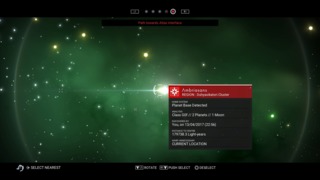
“The cycle is complete. The cycle continues.” In the end, all existence is governed by monolithic, complex algorithms. Nada and Polo are just the result of “brutal causation,” coded means to guide us on our path. The whole universe, like the game itself, does exist only for the purpose of our space odyssey: if we continue our voyage to the center it'll lead us to the edge of the galaxy where a new star is born thanks to the acquired ten Atlas stones, for us to start anew, yet given its open-ended nature we might as well end the game before completing the cycle without getting the feeling of missing the core of the gaming experience.
No Man's Sky without doubt has more flaws than assets: the planet landscapes with their inverted-ish color schemes might look appealing, yet they are often void of any action other than scanning scarce species, mining marooned minerals, and reorganizing our inventory.
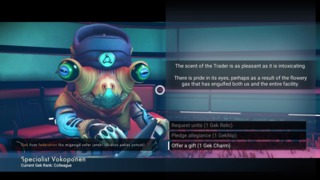
NPC interaction is reduced to the occasional Gek, Vy'keen or Korvax inside some trading base or observatory, but never outside, and animals can be fed but not tamed though having a pet companion for the lengthy excursions would have been a nice addition. Nor can we meet other real-life players, just visit their home base (a remarkably lucky discovery), and so alike the spaceship battles any hostile encounter is necessarily an artificial intelligence one.
Thus lost and lonely, the developers seemingly wanted No Man's Sky to be a space “survival” game for its providing exploration rather than trading or combat, neither one being of vital importance, and even more so when choosing Survival or Permadeath mode with lesser resources and more aggressive enemies and hazards than the Normal or Creative exploration.
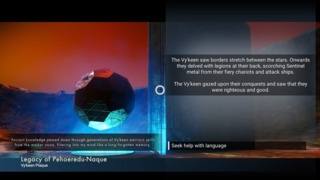
Another form of quiet player interaction are the console and monolith puzzles mostly related to the rites and history of the known three alien species, easy number mini-games and encrypted riddles which get the easier to resolve the more we gain in vocabulary (“Babelfish”): “The lifeforce of another planet pulses from the portal. Invisible yet tangible, I hear it calling out... The portal remains dormant. A lonely silence hangs heavy in the air.”
Apart from some of the planets' hostile atmospheric conditions (while gravity doesn't seem to vary much) it is the inventory that is our worst enemy for almost the entire journey, and expanding it is expensive. Though relatively easy for the Exosuit where we can subsequently purchase slots from the Drop Pods found on the planet surface, a decent spaceship with up to 48 slots has to be bought or located, and in the latter case may take ages to be entirely repaired, requiring an eight-digit number of units or more. If the subsequent updates add the possibility of creating containers and purchasing freighters for additional storage capacity (including various ships), transferring items isn't really made any easier since already the starship inventory becomes inaccessible when out of reach.
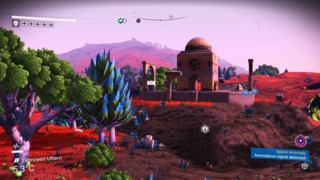
The base building feature once settled down works surprisingly well for the construction of cheap, prefabricated structures around our habitable base while making it look like the common alien shelter, but it still feels like “home” in an otherwise unbordered, open space. Likely having chosen the first available one, in our case the French-sounding "Dorinblonc Epan" in the Ambriasans system in spite of its rather inhospitable climate, we can transfer our home base to any other appropriate planet system if we can't warp back or don't want to, in which case we have to rebuild the structures, but maintain the recruited specialist crew and “most” of the dismantled resources (our oh-so-precious Dynamic Resonator got lost in the ether, though).
The game distinguishes between common, uncommon, and rare materials that are, as their quality suggests, increasingly difficult to find or to farm, even if story-related. While some might be bought from Galactic trade terminals on space stations, others are available under specific planetary conditions only or require special technologies such as the Exocraft mining laser or the Haz-Mat gauntlet which are crafted by means of the blueprints we get via the questlines of the very home base specialists we recruit. Some (increasingly redundant) blueprints providing upgrades for either our Exosuit or the multi-tool are rewarded upon complying with the requests of some random lifeform NPCs, while others have to be purchased along with the starship ones from the space station blueprint traders by means of extracted Nanite clusters and are quickly sold out unless we travel to the next star system.
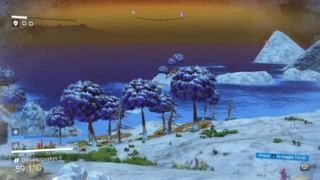
To be sure, the more we increase our crafting skills the more the game gains immediate play value, but the way there is an asteroid-filled one and requires more preparatives than many players might have the patience for. But still, if this generated universe appears infinite and our journey through it interminable, its spatio-temporal extendedness makes No Man's Sky nonetheless a truly epic adventure with ourselves starring as the lonesome hero that is worth dipping into.
